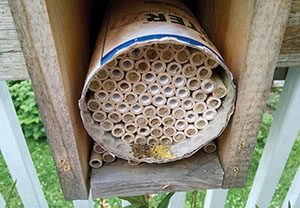Chemical Ecology Could Address Pests, Help Pollinators
 |
|
A solitary bee nest. Source: Jennifer Thaler, Cornell University |
In a commercial orchard, in a tree, you may have seen a special trap—a sticky card—that uses insect pheromones to trap pests. But have you spent much time thinking about how plants use defensive chemicals as well?
Plants use a variety of natural defense mechanisms to counter attacks by pests. Some plants emit chemical “help” signals that call natural enemies—such as beneficial insects—to their aid. Farmers can manage crops to maximize plant defenses.
In nature, insects not only send chemical signals to each other, but also to other plants. Meanwhile, plants send chemical messages to insects, to other plants, and within parts of a single plant. Nature abounds with chemical signals. Scientists hope to better understand these signals to control pests as well as support bees and other beneficial insects.
The Northeastern IPM Center is part of a five-year, multi-state research and extension project that began in 2015 to harness chemical ecology to address pest and pollinator priorities. These efforts aim to reduce the impacts of insect pests, protect valuable pollinators, support organic agriculture, and develop holistic, ecology-based systems.
The total value of principal crops in the Northeast is greater than $5.3 billion. Northeast vegetable growers harvest crops with a value of over $300 million. Meanwhile, demand for organic fruit and vegetables continues to grow, and producers are demanding holistic, ecology-based systems.
On one level, researchers are studying the chemical structures of the substances that mediate communication between pests, crops, and beneficial organisms. Scientists are also interested in understanding the effects of pesticides on non-target organisms such as pollinators and natural enemies of pests. Another area of interest is the effects of domestication on plant and animal chemical ecology. Do these chemical communication channels become weaker after years of domestication? Are there ways humans can maintain their strength for optimal crops?
This project represents a departure from many typical studies that focus on a particular crop or pest. It essentially is a holistic and interdisciplinary project.
Practical outcomes of the project could be a method to suppress agricultural pests, develop crops that resist or do not attract pests, or finding out how to create chemical volatiles that could repel pests from crops.
This multi-state effort allows for a comprehensive approach to studying chemical ecology in pests and pollinators, as well as share resources such as expensive analytical instruments.
In one area of study, for example, scientists are trying to determine which plant volatile chemicals lure natural enemies to the plant and defend it. Researchers have found evidence that plants attract natural enemies when attacked. However, it’s not a simple relationship, as there may be unwanted side effects, such as the attraction of predators and parasites that attack natural enemies as well. Researchers are hoping to understand these relationships better.
Researchers are also trying to understand the effects of pesticides and secondary metabolites in pollen and plant nectar, and how these may influence pollinator infection dynamics. They also want to be able to understand better if pollinators self-medicate, or create their own medicine, when exposed to secondary compounds in flowers.
With this knowledge, farmers could better manage crops, maximize plant defenses, control pests, protect pollinators, support organic agriculture, by using holistic, ecology-based systems.
For further details, see http://neipmc.org/go/AWWp
— by CHRIS GONZALES
The Northeastern IPM Center promotes integrated pest management for reducing risks to human health and the environment. If republishing our news, please acknowledge the source (“From Northeast IPM Insights”) along with a link to our website.
